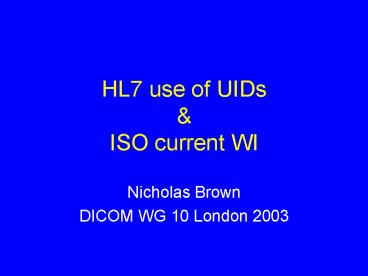HL7 use of UIDs - PowerPoint PPT Presentation
Title:
HL7 use of UIDs
Description:
Implied use: extension is locally unique user friendly identifier. If absent root is the UID. ... a locally unique user friendly ID ?? Length not defined ... – PowerPoint PPT presentation
Number of Views:21
Avg rating:3.0/5.0
Title: HL7 use of UIDs
1
HL7 use of UIDs ISO current WI
- Nicholas Brown
- DICOM WG 10 London 2003
2
Object identifier needs
- Which it is (globally unique)
- Who created it
- Where the master copy is to be found
- Where a local copy is available for rapid access
- Which and where may be combined into one
field but this is not thought to be a good idea
by some but may not be too bad according to Fred!
3
HL7 Ver 3 Provision text 1
- Defines UID data type
- 2 main fields called
- Root
- Extension
- Implied use extension is locally unique user
friendly identifier. If absent root is the UID.
If present concatenate root and extension to
obtain globally unique ID
4
HL7 Ver 3 Provision text 2
- Text description makes clear that the
specification of root is as a globally unique
identifier such as used by DICOM. In particular
it says that semantics may be inferred but that
this use is not supported by HL7 - Woody keen on use of GUIDs - 128 bit UIDs in Hex
as used by Microsoft.
5
HL7 Ver 3 Provision text problems ?
- Maybe precludes the use of a globally unique UID
such as DICOM uses and a locally unique user
friendly ID ?? - Length not defined
- (HL7 lengths are only recommended not mandatory)
- Format not defined
- Multiplicity? (maybe allows global and local)
- How use Ver 3 to support need for 3 UIDs to
identify and access a DICOM object?
6
Current ISO WI for exchange format for UIDs
- Explain use of UIDs
- Feasibility and efficiency of fixed length
- Justification for separating which is it from
who created object and where it can be found - Propose
- 64 char alphanumeric string (supports 64 char
DICOM and 32 char GUID) - Separator to be period
- No leading or trailing spaces etc (current ISO
logical only)
7
HL7 view
- Strong opposition to fixed length
- Need to support customer request to combine
which is it and where/who much more than 64
chars. - Combining classical root and free format for
local ID is a neat idea.
8
IHE use of HL7 and DICOM
- Conflict in use of UID may pose serious problems
for interoperability of DICOM and HL7 Version 3 - Ver 3 ideas not yet tested in the real world































